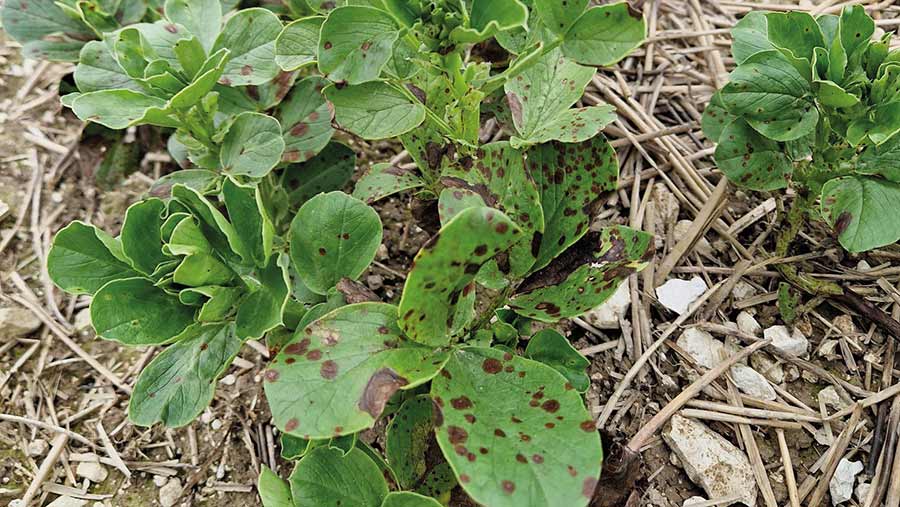Advice for winter bean crops hit with chocolate spot disease
 © Peter Cowlrick
© Peter Cowlrick Winter bean crops have been struck by a widespread influx of chocolate spot.
Growers are advised to spray infected crops earlier than usual if weather remains unsettled to get on top of the disease.
We ask two experts for their advice this season.
See also: Shallower potato cultivation depths recommended in wet season
Why is the disease prominent?
Frosty winter conditions hit crops hard this season with temperatures plummeting as low as -10C.
Cool and wet conditions throughout March and April exacerbated disease risk and restricted early spring recovery.
Becky Howard, PGRO research and development manager, says the number of samples sent through the organisation’s plant clinic infected with chocolate spot are notably higher than usual.
“Many crops were early-sown this season into good seed-beds. But earlier drilling increases risk of chocolate spot as crops emerge sooner to develop a larger, lusher canopy, which is susceptible to disease.
“Winter frosts then damaged the leaf surface allowing the botrytis pathogen to infect crops,” says Dr Howard.
Wet spring conditions created the perfect environment for the disease to thrive, with fungal spores spreading via rain splash from existing lesions on lower leaves to new growth.
Debris from previous crops and nearby bean volunteers have also contributed.
What are the recommendations for infected crops?
Independent AICC agronomist Peter Cowlrick of CCC Ltd, based in Hampshire and West Sussex, advises an early pre-flowering fungicide spray for high-pressure October-drilled crops.
Typically, the first fungicide spray for winter beans is during early flowering at the beginning of May (T1 timing). The second is applied three to four weeks later at the T2 timing.
“Crops remain two to three weeks away from the flowering period. Where disease pressure is high and weather conditions allow, an early holding spray before flowering will help control disease,” he says.
As most fungicide treatments have protectant rather than curative properties, Mr Cowlrick recommends applying the spray after three to five days of dry weather.
This ensures new leaf growth is protected from infection as chemistry can only prevent new leaves from becoming infected.
Which actives and rates to use?
A sufficient range of actives are available to control the disease, but assessing the order of application will be an important decision for growers and agronomists.
- Signum (boscalid + pyraclostrobin)
- Elatus Era (benzovindiflupyr + prothioconazole)
- Azoxystrobin
- Tebuconazole
- Metconazole
Under high disease pressure, rates should not be dropped below 75% of the recommended dose, warns Dr Howard.
“Chocolate spot is responsive to dose rate and keeping disease under control with effective doses is key to its long-term management and reducing resistance build-up,” she says.
However, Dr Howard notes the importance of checking labels for application restrictions.
For example, azoxystrobin can only be used from first flowering at GS60, and tebuconazole from stem extension at GS40.
“Chocolate spot needs careful management as it can be a very damaging disease. Better weather forecast this week offers a good opportunity for growers to get on the ground,” she says.
Mr Cowlrick is recommending high-disease crops with a three-quarter rate of an approved Tebuconazole at the pre-flowering spray for cost-effective control, followed by Elatrus Era (benzovindiflupyr + prothioconazole) at T1.
“This is only applicable to high-pressure, early-drilled crops. That’s why close monitoring by growers and agronomists is important to keep an eye on things,” he says.
If chocolate spot pressure remains high, he advises an application of Signum (boscalid + pyraclostrobin) or azoxystrobin plus Tebuconazole at T2.
How can crop nutrition combat disease?
Optimum nutrition promotes good crop health, which is why soil P and K indices are important.
Too low indices can increase disease susceptibility. That’s why topping up with foliar sprays can be beneficial.
“Magnesium is one to watch in winter beans as it affects overall plant health,” says Mr Cowlrick.
“The addition of Epsom salts to a tank mix can provide a simple way of getting magnesium to the plant, but do check compatibilities prior to mixing,” he says.
Manganese, molybdenum, boron, sulfur and zinc also play important roles.

